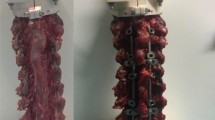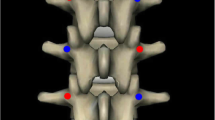Abstract
Regular hooks lack initial fixation to the spine during spinal deformity surgery. This runs the risk of posterior hook dislodgement during manipulation and correction of the spinal deformity, that may lead to loss of correction, hook migration, and post-operative junctional kyphosis. To prevent hook dislodgement during surgery, a self-retaining pedicle hook device (SPHD) is available that is made up of two counter-positioned hooks forming a monoblock posterior claw device. The initial segmental posterior fixation strength of a SPHD, however, is unknown. A biomechanical pull-out study of posterior segmental spinal fixation in a cadaver vertebral model was designed to investigate the axial pull-out strength for a SPHD, and compared to the pull-out strength of a pedicle screw. Ten porcine lumbar vertebral bodies were instrumented in pairs with two different instrumentation constructs after measuring the bone mineral density of each individual vertebra. The instrumentation constructs were extracted employing a material testing system using axial forces. The maximum pull-out forces were recorded at the time of the construct failure. Failure of the SPHD appeared in rotation and lateral displacement, without fracturing of the posterior structures. The average pull-out strength of the SPHD was 236 N versus 1,047 N in the pedicle screws (P < 0.001). The pull-out strength of the pedicle screws showed greater correlation with the BMC compared to the SPHD (P < 0.005). The SPHD showed to provide a significant inferior segmental fixation to the posterior spine in comparison to pedicle screw fixation. Despite the beneficial characteristics of the monoblock claw construct in a SPHD, that decreases the risk of posterior hook dislodgement during surgery compared to regular hooks, the SPHD does not improve the pull-out strength in such a way that it may provide a biomechanically solid alternative to pedicle screw fixation in the posterior spine.


Similar content being viewed by others
References
Arlet V, Marchesi D, Aebi M (1998) Correction of adolescent idiopathic thoracic scoliosis with a new type of offset apical instrumentation: preliminary results. J Spinal Disord 11:404–409
Arlet V, Papin P, Marchesi D, Aebi M (1999) Adolescent idiopathic thoracic scoliosis: apical correction with specialized pedicle hooks. Eur Spine J 8:266–271
Barr SJ, Schuette AM, Emans JB (1997) Lumbar pedicle screws versus hooks. Results in double major curves in adolescent idiopathic scoliosis. Spine 22:1369–1379
Been HD, Kalkman CJ, Traast HS, Ongerboer dV (1994) Neurologic injury after insertion of laminar hooks during Cotrel-Dubousset instrumentation. Spine 19:1402–1405
Berlemann U, Cripton P, Nolte LP, Lippuner K, Schlapfer F (1995) New means in spinal pedicle hook fixation. A biomechanical evaluation. Eur Spine J 4:114–122
Berlemann U, Cripton PA, Rincon L, Nolte LP, Schlapfer F (1996) Pull-out strength of pedicle hooks with fixation screws: influence of screw length and angulation. Eur Spine J 5:71–73
Berlet GC, Boubez G, Gurr KR, Bailey SI (1999) The USS pedicle hook system: a morphometric analysis of its safety in the thoracic spine. Universal Spine System. J Spinal Disord 12:234–239
Bridwell KH (1997) Spinal instrumentation in the management of adolescent scoliosis. Clin Orthop Relat Res 335:64–72
Bridwell KH, Hanson DS, Rhee JM, Lenke LG, Baldus C, Blanke K (2002) Correction of thoracic adolescent idiopathic scoliosis with segmental hooks, rods, and Wisconsin wires posteriorly: it’s bad and obsolete, correct? Spine 27:2059–2066
Cohen-Gadol AA, Dekutoski MB, Kim CW, Quast LM, Krauss WE (2003) Safety of supplemental endplate screws in thoracic pedicle hook fixation. J Neurosurg 98:31–35
Hackenberg L, Link T, Liljenqvist U (2002) Axial and tangential fixation strength of pedicle screws versus hooks in the thoracic spine in relation to bone mineral density. Spine 27:937–942
Halvorson TL, Kelley LA, Thomas KA, Whitecloud TS III, Cook SD (1994) Effects of bone mineral density on pedicle screw fixation. Spine 19:2415–2420
Kothe R, Panjabi MM, Liu W (1997) Multidirectional instability of the thoracic spine due to iatrogenic pedicle injuries during transpedicular fixation. A biomechanical investigation. Spine 22:1836–1842
Krag MH (1991) Biomechanics of thoracolumbar spinal fixation. A review. Spine 16:S84–S99
Liljenqvist U, Hackenberg L, Link T, Halm H (2001) Pullout strength of pedicle screws versus pedicle and laminar hooks in the thoracic spine. Acta Orthop Belg 67:157–163
Liljenqvist U, Lepsien U, Hackenberg L, Niemeyer T, Halm H (2002) Comparative analysis of pedicle screw and hook instrumentation in posterior correction and fusion of idiopathic thoracic scoliosis. Eur Spine J 11:336–343
Liljenqvist UR, Halm HF, Link TM (1997) Pedicle screw instrumentation of the thoracic spine in idiopathic scoliosis. Spine 22:2239–2245
McLain RF, Yerby SA, Moseley TA (2002) Comparative morphometry of L4 vertebrae: comparison of large animal models for the human lumbar spine. Spine 27:E200–E206
Muschik M, Schlenzka D, Robinson PN, Kupferschmidt C (1999) Dorsal instrumentation for idiopathic adolescent thoracic scoliosis: rod rotation versus translation. Eur Spine J 8:93–99
Papin P, Arlet V, Marchesi D, Rosenblatt B, Aebi M (1999) Unusual presentation of spinal cord compression related to misplaced pedicle screws in thoracic scoliosis. Eur Spine J 8:156–159
Roach JW, Ashman RB, Allard RN (1990) The strength of a posterior element claw at one versus two spinal levels. J Spinal Disord 3:259–261
Suk SI, Kim WJ, Lee SM, Kim JH, Chung ER (2001) Thoracic pedicle screw fixation in spinal deformities: are they really safe? Spine 26:2049–2057
Suk SI, Lee CK, Kim WJ, Chung YJ, Park YB (1995) Segmental pedicle screw fixation in the treatment of thoracic idiopathic scoliosis. Spine 20:1399–1405
van Ooy A, Geukers CW (1992) Results of CD operation in idiopathic scoliosis. Acta Orthop Belg 58(Suppl 1):129–133
Vanichkachorn JS, Vaccaro AR, Cohen MJ, Cotler JM (1997) Potential large vessel injury during thoracolumbar pedicle screw removal. A case report. Spine 22:110–113
Acknowledgments
Acknowledgments to B/Braun Aesculap Netherlands for providing the implants. There was no financial assistance provided. Non of the authors has any financial interest in B/Braun Aesculap or any of the material presented.
Author information
Authors and Affiliations
Corresponding author
Rights and permissions
About this article
Cite this article
van Laar, W., Meester, R.J., Smit, T.H. et al. A biomechanical analysis of the self-retaining pedicle hook device in posterior spinal fixation. Eur Spine J 16, 1209–1214 (2007). https://doi.org/10.1007/s00586-006-0288-4
Received:
Revised:
Accepted:
Published:
Issue Date:
DOI: https://doi.org/10.1007/s00586-006-0288-4




